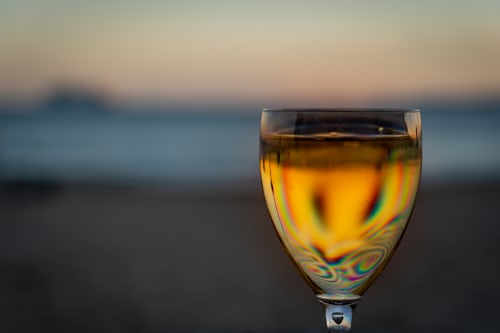Little did you know, you aerate it every time you open a bottle! Even if you pour your wine into glasses and swirl around to release all the flavors, you aerate it all the time. When wine is exposed to air, oxidation and evaporation are triggered. Oxidation is the result of a chemical reaction when something is oxygen exposed (think of the browning of apple slices too long if left out). Aeration occurs when a liquid becomes steam and flows into the air, as you probably know all too well from your 3rd-grade courses. In this article, you will learn whether or not do you need to aerate white wine!
Aerating Wine

Don’t panic now. Your precious wine will not evaporate into thin air magically if you don’t drink it quickly enough. This form of evaporation refers to the evaporating wine’s unwanted components, leaving the good things behind.
The dynamic aeration duo of oxidation and evaporation removes some aspects of your wine while simultaneously enhancing others. Your wine will, therefore, smell and taste much better.
In the meantime, you probably wonder which wines will benefit from aerating. If it makes wines taste and smell better, why wouldn’t all wines aerate? Appropriate question. However, not all wines do well with aeration, mainly white, as we said earlier.
Dense, full-bodied red wines are going to do better with some air. The reason is that these wines can be exposed to oxygen for a long time without losing flavor.
Do You Need To Aerate White Wine?

Many people know the concept of allowing red wine to breathe or ventilate it more efficiently. Still, many are unsure whether white wine needs aeration, especially because it usually contains less bitter tannins.
However, white wine can benefit from ventilation and red wine – oxygenation still ‘open’ all flavors and flavors. Cheaper white wines can often be smooth or tang, which can be aerated while offering hidden fruity or floral fragrances.
All the white wines are aerated, whether you prefer chardonnay, pinot grigio, or Moscato, but dry white wines and a more tannic oaky palate show the most significant difference. Try airing a chardonnay, white sauvignon, Bordeaux white, or Bordeaux to wake up your delicious tastes.
Do You Need To Aerate White Wine: Knowing Which Ones

As a rule, it’s better to keep the whites with the same sizes, depths, and complexity as your typical shrinking red wine, like Alsace, Burgundians, White Bordeaux, Chardonnays, and Sauvignon Blancs.
These whites can sit in a decorative decanter for 30 minutes – but allowing a white to sit for an extended period can be dangerous: it is cool.
When served cold, whites are optimal. The science behind why helps boost the flavors and aromas filled with fruit in the wine and highlights its natural acidity. And, to be honest, who does not like a good white wine ‘s traditional crisp impression?
To keep your whites cool, though oxidized, an electronic wine aerator could best immediately open up the taste of your wine without sacrificing its fresh profile.
White wine experts stress how important it is to experiment with how much your wine wants to ventilate – but that can be a waste of a perfectly good bottle! But don’t be afraid, if you own an electric aerator, you can do your mad scientist oxidation experiment per glass instead of an entire bottle.
Do You Need To Aerate White Wine: How To Do It

The fact that white wine is breathable in a glass or decanter for an hour at room temperature is not ideal, as most prefer a cold, crisp, white wine from the refrigerator. This makes an electronic wine aerator perfect for white wine – you can aerate in just a few seconds from the refrigerator to keep it refreshingly cold and even more delicious.
It is only possible to aerate selected types of white wines; not all kinds should be aerated. White wines should have a bold, dry, and full taste, just like red wine. Bordeaux, Corton-Charlemagne, and Alsace are white wine types that need an aerator. These types also contain tannins that must be defined and evaporated.
The downside of letting white wine come is that it loses its chill; the coldness is removed from the wine with a decanter. That’s why it’s better to use an aerator for wines such as these to aerate the wine while still chilled. Once the wine is poured into a glass, the bottle may be placed in the refrigerator.
More Information
The reason is most likely that these white wines do not match their aroma and taste our bottle of wine is that they need aeration. White wines need to be served at a colder temperature than red wines so that they can be left out for a while but do not get warm.
There are different ways to aerate and decant your wines that are price-consuming, but you can find some affordable decanters and aerators in the case of white wines.
Red wines have become increasingly popular because of their more tannins and their advantages towards age. Decanter is useful in all wines, but in particular in reds. White wines also benefit from breathing.
What Is A Wine Aerator?

A wine aerator works through greater oxidation of the wine than is normally achieved by breathing your wine alone. Although devices exist, the vast majority do not comply with the Sommelier aerating wine standards.
The key to a good wine aerator: As the wine hits the glass, you must be able to see the bubbles, which shows that the correct amount of oxygen has been introduced. You also want a wine aerator pourer that dispenses the wine as it is oxidized. Finally, the best wine aerators do not use expensive CO2 refills, which can significantly increase the price.
Oxygen is both the best and the worst thing your wine can do, particularly red wine. The introduction of oxygen in the glass of wine causes the wine to awaken from sleep. The difference in the aroma is so noticeable that a wine beginner can tell the difference.
And as 70 percent of the wine is based on aroma, this is no small feat that the aerator does. However, it should be warned that leaving the wine to absorb more oxygen during a few days significantly reduces the quality of your wine, making it a fantastic vinegar.
So fast controlled aeration is important, but your aerator should also prevent undesirable excess oxygen from entering. Seek an aerator that can seal and dispense the wine and ventilate it. It’s all about controlling the quality of your wine glass.
After three bottles, you’ll earn more than your money back. A high-quality aerator can make a wine taste twice as expensive, almost instantly turning the $10 bottle into a $20 bottle. You ‘re going to get the taste twice at the same price. However, be warned that it may be difficult to return to unaerated wine.
Final Words
Before the wine is filled into the aerator, the first step is to know what type of wine to aerate. Aeration will most benefit young red wines and white wines. But there are wines, like Pinot Noir, Burgundy, Beaujolais, and the Côtes du Rhone, lightening Zinfandels and light Chianti and Dolcettos, which need not be breathed at all. Cheap, ready-to-eat wines need not be aerated. With the right wine type to aerate, the unwanted expectations will be removed from the aerator.






